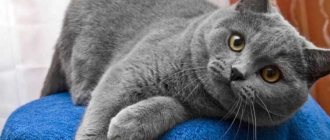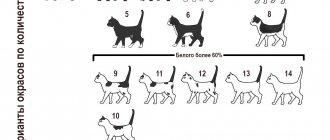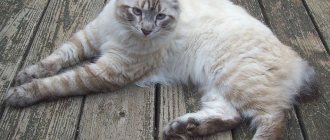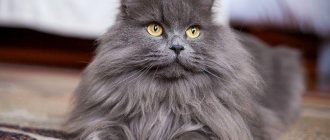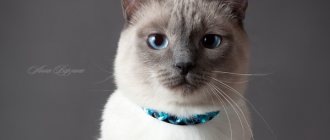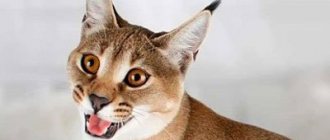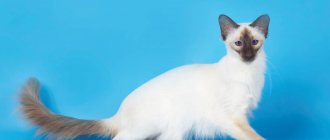There is a legend about how one day a passionate attraction broke out between a Bengal leopard and a cat, which led to the appearance of Bengal cats. However, it was never possible to reliably find out where these animals, unusual in appearance and character, came from.
What is absolutely known is that until the middle of the last century, Bengal cats were the object of hunting, and they were exterminated at an incredible rate because of their beautiful skins. This species has become endangered. Even if live Bengal kittens were sold, many new owners were unable to cope with their wild nature.
The first person to start breeding this breed was Jane Mill. The success of breeding was relative at first, but gradually things improved, and by the end of the century the Bengal cat became a regular participant in exhibitions.
Description of the breed
The breed arose not so long ago - in the 80s of the last century, thanks to the crossing of a wild Bengal cat and an ordinary domestic cat. The breeder wanted to create a hardy breed, which in terms of physical characteristics is not inferior to a wild cat and at the same time remains affectionate and devoted to its owner, like a domestic cat.
Average life expectancy is 15 years.
Color
You can identify a Bengal by its characteristic coloring, which resembles the color of a leopard. Because of this, the Bengal cat is sometimes called a leopard cat, but the breed itself has nothing in common with this animal. The pattern on the skin is represented by a marbled or spotted pattern. There are several varieties of color:
- a spot or rosette on gold;
- marble on gold;
- a spot or rosette on silver;
- marble on silver;
- snow.
The coat is short, dense, shiny and silky to the touch. An important element in identifying the breed will be the presence of spots (patterns) on the belly.
Body Shape
In relation to the body, the head is small and elongated. The body is proportional, harmoniously built. The legs are long, the hind legs are slightly longer than the front ones. The tail is of medium length, round at the end. The ears are small, wide at the base and pointed at the tips.
Males are larger and reach 8 kg. This is a strong and hardy animal.
Character
Representatives of the breed are not dangerous to humans. By nature they are friendly, loyal and willing to make contact. They love their owner, although they can show autonomy and independence.
Bengals inherited the hunting instinct, so they are quite playful and active. After going through adolescence, these exotic cats are still interested in play and are easy to train. They are very smart and can learn to open doors and operate light switches on their own.
Bengals also get along well with children and can even tolerate encroachment on their comfort zone for some time. They do not have conflicts with other cats, but are considered prey for birds and small rodents. They respond well to training.
Suitable for active, friendly people who are willing to spend time communicating and playing with a cat.
Bengal cat lovers clubs
Since cats of this breed are very famous, it is not surprising that there are many clubs for Bengal cat lovers. The purpose of communication between club members is to share the intricacies of caring for their pets, the characteristics of their diet, or how to treat certain diseases.
Also, this is the most suitable place to show off the achievements of your Bengal, because this is where people come who really understand this and are able to appreciate your efforts with your pet.
Maintenance and care
The cat is clean and does not require special hygienic care. Be prepared to try to take baths together - Bengal cats are not afraid of water, and on the contrary, they try to swim at the first opportunity.
It is important to trim nails regularly. Read my article on how to trim your cat's nails at home. There are clear illustrations on how to do this correctly and painlessly.
It is recommended to train your cat so that it can follow simple commands. This will make it easier to keep your pet and help maintain its health.
A Bengal cat should have its own space at home. It is best to create a whole complex that will include a scratching post, a house, beds and toys. Read about how to make a scratching post for a cat in a separate article. Additionally, purchase a set of cat toys, because if you don’t have them, your cat may use your things.
Nutrition
It is best to feed your Bengal cat professional premium food. The breeder from whom you are purchasing a cat will help you make it easier for you to choose a food manufacturer.
You can leave your cat on homemade food. This option is more costly in terms of effort and time. A professional nutritionist will help you balance your diet. Here is a sample list of foods for the diet of Bengal cats:
- lean meat (chicken, turkey) – 50-60% of the diet
- vegetables – 20%
- fiber – up to 7%
- fermented milk products – up to 20%
Depending on activity and weight, an adult Bengal cat requires 50 to 85 grams of dry food daily, unless supplemented with other foods.
Nutrition
Bengal cats are carnivores. Often, cat owners (of any breed) forget about this obvious fact. Look at commercial foods and you will see that they contain very little meat, a lot of corn, wheat, soy, potatoes, rice. These types of feeds have only been around for about 60 years. So why are they so in demand? The answer is obvious - they are cheap. Do these foods provide enough nutrients for the cat to survive? Yes. Will my cat thrive on this food? No and no again. The most reliable alternative to such nutrition is natural meat, fish, and vegetables.
Give your Bengal cat plenty of natural foods. Sometimes owners are perplexed: “How can you feed a cat only meat or fish, and even raw?” This is the most natural food for her; we don’t think anyone believes that for the previous 9,000 years the cat ate exclusively dry food and canned food.
Health
Representatives of this breed are not excessively sick cats, but have a number of features that are important to know in order not to harm and to treat in time.
It is important to know that Bengals cannot tolerate a number of medications and do not respond well to anesthesia. Trust treatment only to experienced doctors.
Be sure to castrate or neuter your animals if you do not plan to breed. This will protect animals from hormonal imbalances, cancer and other diseases.
Loose bowels
Bengal cats are susceptible to food poisoning and intestinal diseases. It is important to feed your pet only high-quality professional food, monitor the expiration date of the food and its freshness. Frequent changes in food can cause digestive upset and an inflammatory reaction.
The water must be clean. The owner needs to regularly wash the cat’s bowls, tray and toys, and also monitor the pet’s general hygiene.
Cardiac pathology
A third of Bengal cats experience hypertrophic cardiomyopathy. This disease is expressed in a pathology of the structure of the heart, when one wall is thicker than the other.
There are no early symptoms, so regular visits to the doctor and a heart examination - ultrasound and cardiogram - are required. The disease affects the functioning of other organs and can lead to blood clots and death.
Weak immunity
If a cat is the product of a mating of closely related individuals, most likely he will have weak immunity. Therefore, it is important to regularly vaccinate, get rid of parasites and feed your pet well.
To develop and maintain a strong immune system, you need to take vitamins, eat natural, high-quality food, and add physical activity to your cat’s life.
Coat and color
The coat is short or medium in length, close to the body, quite dense, but at the same time very silky and soft. The bright markings create an excellent contrast with the main tone.
The color of Bengal cats is a distinctive feature of the breed. It can vary within brown tones. But besides them, there are snow and silver colors.
Regardless of the basic tone, the animal’s coat must have a pattern - marbled, rosette or spotted. At the age of four weeks, kittens tend to lose their bright colors. But don't worry, he will recover in ten months. This is a genetic feature of Bengals.
Reviews
I reviewed the reviews from the Otzovik website and chose the most interesting statements about the breed.
Smart and resourceful
The author draws attention to the fact that the cat is very friendly and adapts to the owner’s character. Separately notes the ingenuity and activity of the pet. Of course, I would like to praise the owner: she reacts with humor to all manifestations of the cat’s thriftiness.
Peaceful and kind
The author of the following review begins by saying that her cat combines the tenderness of a domestic animal and the habits of a wild one. But this does not affect the relationship with the residents of the apartment - the pet is not aggressive towards people and its relatives. Separately, the author draws attention to the cat’s talkativeness and a certain willfulness.
Loud voice and gastrointestinal problems
The following review is interesting because the author confirms that the breed has some problems - weak intestines and the need to carefully choose food. Inside the review, the owner talks about the cat’s activity and excessively loud voice, especially if it’s time to eat.
Video
* We invite you to watch a video about the Bengal cat . In fact, in front of you is a playlist in which you can select and watch any of 20 videos about a given cat breed by simply clicking on the button in the upper right corner of the window. In addition, the material contains quite a lot of photos. By looking at them you can find out what a Bengal cat looks like.
In this article:
|
How to cope with loneliness
Bengals are very dependent on their usual society. Being infinitely loyal, they strive to always accompany their person. They will happily keep the owner company, either lying on the sofa or bed, or preparing food in the kitchen or relaxing in the bathroom. Any separation from the owner is stressful for the pet, and lack of attention will make the animal distrustful and wild. Therefore, these cats are not suitable for those who are constantly at work or study.
Photo: @kara_ohhh/Instagram
Appearance
Bengals are considered to be very large in size. In fact, they are not much larger than the average house cat. The average body weight is 6 kg, but some specimens can weigh 8.5 kg. And these are usually males. An adult Bengal cat is significantly different in size from a female cat. Therefore, it is males that are most often presented at exhibitions. The average height of a Bengali is 26-33 cm.
Leopard coloring is a distinctive feature of the breed. The entire body is covered with spots: round, oval or slightly elongated. The body can also be decorated with rosettes - spots with a dark edge and a light center. There must be spots on the stomach as well. Marbled cats have horizontal, sinuous stripes adorning their bodies.
The color of the muzzle is “wild”: there is the letter “M” on the forehead, dark stripes on the cheeks. The neck is decorated with a dark colored necklace. Small spots are scattered on the shoulders. The paws are either spotted or streaked. The tail can be either spotted or edged with stripes.
Felinological organizations recognize the following colors:
- Brown Tabby (Brown Tabby) - the general background of the body is acceptable from golden to chestnut. The greater the contrast between the spots and the background, the better.
- Seal Tabby (Sial Tabby) - snowy. Available in different colors: ivory, cream, beige, light orange with brown designs. A cat with a white color is considered the best representative of the breed.
- Silver Tabby (Silver Tabby) - silver with charcoal gray patterns.
There are also other colors: charcoal, melanistic, blue. However, they are not officially recognized.
The Bengal looks like a wild animal: developed muscles, protruding shoulder blades when walking, a graceful, sneaking gait and, of course, a leopard print. It is by its bright color and clear spots that a real Bengal can be distinguished.
Are Bengal cats hypoallergenic or not? How often do they shed?
Bengal cats are classified as hypoallergenic. They received this title due to the fact that dandruff, which provokes an allergic reaction in people predisposed to it, is formed in a minimal amount.
Savannah (left) and Bengal (right) Photo: @giguerecats/Instagram
Another allergen, a protein from a cat’s saliva, rarely comes into contact with humans and the cat’s fur due to the cat’s lack of habit of constantly grooming itself and licking its owner. Also, being a short-haired breed, Bengals shed very little, and during the shedding season, brushing once a week is sufficient for grooming.


